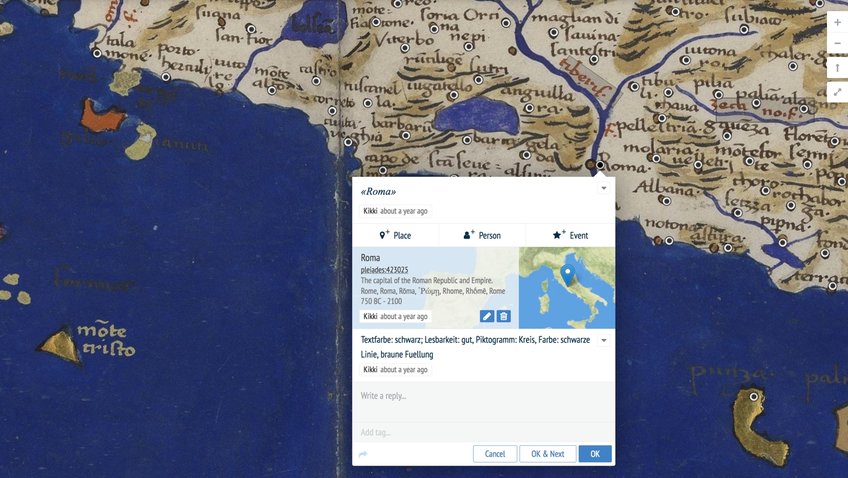
Hertziana Studies in Art History
Hertziana Studies in Art History, HSAH in short, is the digital publication serie for all Hertziana-related scientific output. Its goal is to provide the ideal environment for publications that gain the most from the native digital format through web links, semantic annotations, interactive content and open linked data connections (to name a few).

Vol. 2 - 2023
Visualizing Complexities. Practices and Heuristics of Digital Models in Art History
Edited by Nicola Camerlenghi, Tanja Michalsky & Elisabetta Scirocco
ISBN: 978-3-949381-01-0 DOI: https://doi.org/10.48431/hsah.02
Digital models help to visualize complexities heretofore unapproachable through more conventional methods of art history. The seductive qualities of these models—which tend to transcend those of words—are increasingly untempered by their digital and thus potentially alien nature. Modeling technologies—including, but not limited to, GIS, photogrammetry, laser scanning, VR, AR, or BIM—can assist not only in visualizing, but also in measuring, reconstructing and, thus, analyzing works of art and architecture. With the use of these tools come both challenges and opportunities. Furthermore, the interdisciplinarity of digital approaches invites diverse conventions, and as the media used for digital visualizations are adopted across disciplines and their hermeneutics contested, the resulting epistemes are naturally hybrid. The authors of this volume present and discuss their ongoing projects in art and architectural history involving 3D-modeling. The aim of this collection, stemming from a workshop held in December 2020 at the Bibliotheca Hertziana, is to pose some of the most pressing questions about the process of visualizing artistic complexities.
Nicola Camerlenghi, Tanja Michalsky & Elisabetta Scirocco
Visualizing Complexities. Practices and Heuristics of Digital Models in Art History
Giacomo Landeschi
What is a 3D Model and Why Do We Model? Some Reflections Built Upon Archaeological Case Studies
Angelica Federici
Visualizing Medieval Rome. The Basilica of Sant’Agnese fuori le mura
Giulia Bordi
Visualizing Medieval Rome. Digital Storytelling about the City and its Churches
Nicola Camerlenghi
Virtual St. Paul’s Basilica 2.0. Developing an Open Educational Resource
Fabrizio Nevola, Donal Cooper, Chiara Capulli & Luca Brunke
Bringing Together Geospatial Information, 3D Modeling, Experiential Learning and Research Data. The Ospedale degli Innocenti: A Case Study of the Florence 4D Project
Andrea Giordano & Paolo Borin
Visualizzare la complessità. Fondamenti BIM per il progetto Visualizing Cities
Ruggero Longo
Digitizing Cultural Heritage. Methodology, Potential, and Limits of the Palermo Royal Palace Project
Piotr Kuroczyński
Serious 3D in Art and Architectural History

Vol. 1 - 2022
Walking through history. An Interdisciplinary Approach to Flavio Biondo’s Spaces in the "Italia Illustrata“
Edited by Tanja Michalsky & Martin Thiering
ISBN: 978-3-7774-4069-9 DOI: 10.48431/hsah.0100
This volume presents the results on an ongoing research about the use of digital humanities methods for analyzing spatial meanings in Renaissance texts and maps, specifically focusing on Flavio Biondo’s Italia illustrata. The authors use computational and corpus-driven text and map analysis, as well as cognitive anthropology and gestalt theory, to identify and visualize spatial concepts encoded in historical maps and texts. They aim to discover sources and provide a cognitive map for readers by encoding information in a way that helps readers understand spatial information. The text also discusses the plurality of spaces and the changing perspectives of spatial concepts over time, particularly from the Renaissance to the digital age.
Tanja Michalsky & Martin Thiering
Walking through history. An Interdisciplinary Approach to Flavio Biondo’s Spaces in the “Italia Illustrata”
Günther Görz, Chiara Seidl & Martin Thiering
Linked Biondo: Generating and Processing Research Data Based on Geographical Feature Modeling
Kurt Guckelsberger & Klaus Geus
Measurements, Maps, and Other Source Material in Biondo’s Italia Illustrata: The Example of Latium
Kurt Guckelsberger
Two Great Maps of Italy – A Comparison
Marc Laureys
‘Illustrating’ Italy: Biondo’s Concept of Illustratio
Nathalie Bouloux
L'usage des cartes dans l'Itala Illustrata de Biondo Flavio
Martin Thiering & Raphael Berthele
Some Thoughts on a Spatial Language Analysis of Flavio Biondo’s Illustrated Italy
Kai-Florian Richter
The Description of Places in Biondo’s Italia Illustrata: Outlining a Quantitative Analysis of Their Granularity and Spatial Relationships

